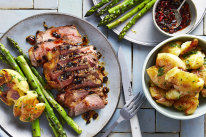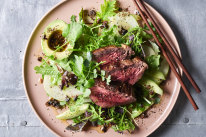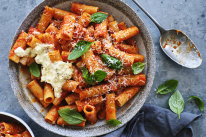Vietnamese-style slow-roasted pork shoulder with lemongrass, and a rice noodle and herb salad
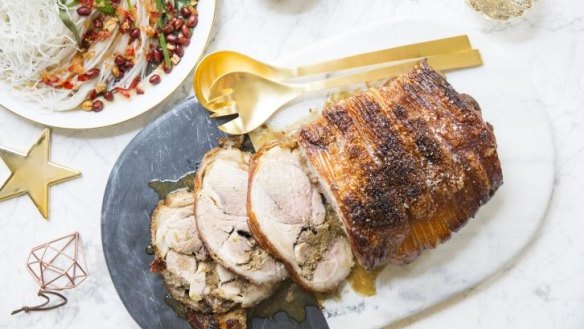
Lemongrass features prominently in this pork dish, which is delicious hot or cold - either intentionally so or as lunch inevitably stretches into the afternoon - served with the cool freshness of the rice noodle and herb salad.
Ingredients
140g brown sugar
140g salt, plus extra
2.5-3kg Berkshire pork shoulder, skin on, unrolled
2 brown onions, sliced into thick rounds
250ml coconut water
50ml rice wine vinegar
Lemongrass paste
5 lemongrass stalks, outer leaves discarded and pale stalks finely sliced (about 130g)
4 eschalots, chopped (about 50g)
6 garlic cloves, chopped (about 20g)
6cm piece ginger, grated (about 25g)
zest and juice of 1 lime
2 tbsp grapeseed or vegetable oil
2 tbsp fish sauce
2 tbsp brown sugar
2 tsp ground white pepper
2 tsp Chinese five-spice
2 tsp chilli flakes
Noodle salad
300ml vegetable oil, plus extra
200g raw (red skinned) peanuts
40g bean thread noodles
500g "bun bo hue" dried rice noodles
1 handful garlic chives, chopped
½ bunch Vietnamese mint, leaves picked
½ bunch Thai basil, leaves picked
dipping sauce (for instructions, see my tuna recipe)
Method
1. Preheat the oven to 160C fan-forced or 180C conventional.
2. For the pork, combine the sugar and 140 grams of salt in a large glass or ceramic dish and rub into the pork thoroughly. Refrigerate for four to six hours (or overnight), skin-side up.
3. For the lemongrass paste, add all the ingredients to a blender and blitz to a rough paste.
4. Lift the pork from the cure and pat dry. Smother the meaty inside with the lemongrass paste, roll tightly and secure with string. Place the onions in a baking tray to act as a trivet and place the pork on top. Pour the coconut water and rice wine vinegar into the tray and rub the skin of the pork with a little extra salt. Cover with baking paper and foil and roast for two hours.
5. Uncover the pork, turn up the heat to 180C fan-forced or 200C conventional and roast for a further one and three-quarter hours.
6. If needed, turn the oven grill on for the last five or 10 minutes of cooking to crisp up the crackling – watch carefully, as it can burn very quickly. Rest loosely covered with foil.
7. For the noodle salad, fry the peanuts in a few centimetres of vegetable oil for four to five minutes until lightly golden. Remove the peanuts from the oil, drain well and season with salt. Set aside to cool, before crushing lightly using a mortar and pestle.
8. Bring the same oil up to about 180C and fry the bean thread noodles until they have doubled in size but haven't taken on any colour – this should only take about 20 seconds. Lift from the oil and drain.
9. Cook the rice noodles in boiling water for about 10 minutes until tender. Drain, refresh under cold water, drain again and toss in a little extra vegetable oil.
10. Arrange the rice noodles in a shallow serving bowl, spoon over the dipping sauce as dressing, scatter over the herbs and peanuts and crown with the fried noodles.
11. When ready to serve, slice the pork and serve with the reduced roasting liquid, if desired. If serving the pork hot, thick slices are best, but if closer to room temperature, I prefer it sliced more thinly. Serve the noodle salad on the side.
Appears in these collections
The best recipes from Australia's leading chefs straight to your inbox.
Sign upFrom our partners
Similar Recipes
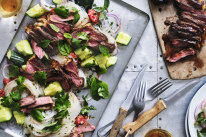
Grilled steak and vermicelli salad with spicy dressing and smashed cucumbers
- 30 mins - 1 hr
- Danielle Alvarez
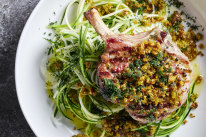
Pepper pork cutlets with pickled zucchini salad and crispy falafel
- < 30 mins
- Jessica Brook
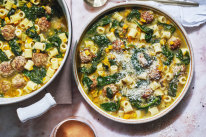
This Italian wedding soup is a marriage of flavours, and you’ll be making it on repeat
- 30 mins - 1 hr
- Danielle Alvarez
More by Karen Martini

Karen Martini’s apple and cherry brown butter cake meets clafoutis pudding
- 2 hrs +
- Karen Martini
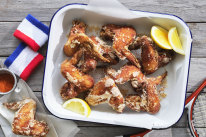
Just add cold beer and serviettes: Karen Martini’s chicken wings are the perfect five-setter snack
- 30 mins - 1 hr
- Karen Martini
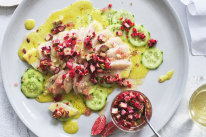
Ceviche with buttermilk dressing and rhubarb, chilli and fennel pickle
- < 30 mins
- Karen Martini

